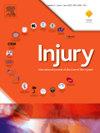Traumatic hip dislocations associated with acute aortic injuries: A relevant injury complex
IF 2.2
3区 医学
Q3 CRITICAL CARE MEDICINE
Injury-International Journal of the Care of the Injured
Pub Date : 2025-01-16
DOI:10.1016/j.injury.2025.112172
引用次数: 0
Abstract
Objectives
The primary aim of this study was to determine if an association exists between traumatic posterior hip dislocations and aortic injuries. Secondarily, this study assessed the incidence of chest imaging in patients with hip dislocations.
Methods
Design: Retrospective Review of a Consecutive Case Series. Setting: Academic level I trauma centre. Patient Selection Criteria: Fifteen-thousand-four-hundred-thirteen consecutive traumatically injured patients with at least one orthopaedic injury were initially identified. After excluding patients without a posterior hip dislocation after blunt trauma, seven-hundred-nine patients were included. Outcome Measurements and Comparisons: The primary outcome was the coincidence of blunt traumatic aortic injury with acute posterior dislocation of a native hip. The secondary outcome was the rates of chest imaging to screen for blunt aortic injuries in patients with posterior hip dislocations.
Results
The incidence of aortic injury with blunt trauma was 5.1 % in patients with a posterior hip dislocation and 1.6 % in patients without a posterior hip dislocation (OR = 3.3, CI: [2.3: 4.7], p < 0.001). Of the seven-hundred-nine patients with posterior hip dislocation, six hundred fifty-nine (93 %) received chest imaging as part of their initial workup, while thirty-four (4.8 %) never received chest imaging during hospitalization.
Conclusions
Despite improvements in automobile safety, this injury complex remains highly relevant. The findings advocate for routine chest imaging as part of the diagnostic trauma workup for patients with a native posterior hip dislocation.
求助全文
约1分钟内获得全文
求助全文
来源期刊
CiteScore
4.00
自引率
8.00%
发文量
699
审稿时长
96 days
期刊介绍:
Injury was founded in 1969 and is an international journal dealing with all aspects of trauma care and accident surgery. Our primary aim is to facilitate the exchange of ideas, techniques and information among all members of the trauma team.

 求助内容:
求助内容: 应助结果提醒方式:
应助结果提醒方式:


